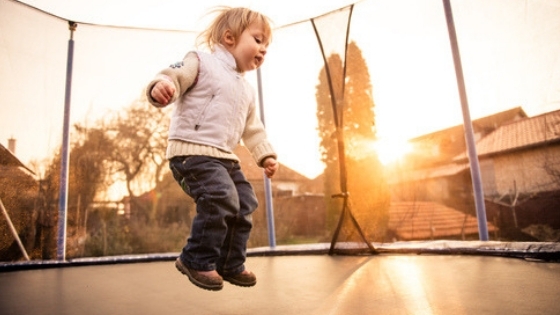Too often, kids nowadays are so glued to their phones, tablets, and computers that they don’t build up their physical strength through sports or other forms of exercise. If you find that your children are not as active as you want them to be, it may be time to buy them a trampoline.
There are accounts of accidents involving trampolines, but before you discount them entirely, there are advantages to buying one. One significant benefit of buying trampolines is that it’s a fun way to exercise. It also strengthens your child’s bones and increases skeletal mass.
If you’re planning to buy a 10ft trampoline for your kinds, here are some questions you need to ask:

- Where is the best place to put it?
Trampolines are best placed outdoors. Look for a place in your backyard that is clear of tree branches, debris, and fences. Clean it up if you need to. This way, you prevent any mishaps from occurring. To find the best spot for your trampoline, make sure that:
- It’s flat and even – The area should be level. If your backyard is a little bit inclined, the rise should not exceed 3° across the entire space.
- There’s enough space – You should have a safe clearance space for your trampoline. It is recommended to have at least 1.5 meters of extra area on all sides of the trampoline and a minimum height clearance of 6 meters from the ground.
Ten feet is the ideal trampoline size for kids between 7 and 13 years old. It’s not too big that it takes up too much lawn space but also not too small that your kids can’t fully enjoy being in there with their friends. Other common trampoline sizes are 8 ft and 13 ft.
- What is the best trampoline shape for your backyard?
There are various designs available today. There are advantages and disadvantages to each type of trampoline shape, so choose the ones that you can live with. Here’s a quick guide:
- Round – This traditional style is the most popular shape. With a round trampoline, the springs send their reaction force evenly throughout the perimeter. This is an advantage if there’s only one jumper as he or she should stay in the middle of the trampoline. However, this shape becomes difficult if your kid and his friends are playing together because it increases the likelihood that they’ll bump into each other and fall off.
- Square – With this shape, the side springs do not react the same way as those of the round trampoline. Jumping straight up on this type of trampoline allows you to land precisely on your starting point. This shape uses your backyard space more efficiently because it can seamlessly fit into a fenced-in area.
- Rectangle – The springs in a rectangle trampoline react in the area near the jumper, similar to those of the square type. A significant difference is that the rectangle trampoline offers a large surface so that more people can use it at the same time.
- Oval – While an oval-shaped trampoline still brings jumpers to the middle. Similar to rectangular trampolines, this trampoline shape provides a large jumping surface but with the added benefit of having several bounce areas that do not interfere with each other so much. This means that multiple players can use the trampoline without bumping to each other all the time.
- Who will be using it?
The type of trampoline you buy should be able to carry the weight of its users. It’s easy if only the kids will be jumping on it, but you may need a heavy-duty model if adults will also be joining in the fun. Determine the maximum user weight that the trampoline can accommodate. It depends on how heavy the users are and how high they jump. This makes sure that jumpers don’t come into contact with the ground while jumping.

- What are its safety features?
Familiarize yourself with the safety features of the trampoline. Various styles may have different characteristics, and the one you choose should have features that ensure your kid’s safety. Your trampoline should have:
- Enclosure net – It covers the sides of the trampoline to prevent kids from falling off. It is typically made of polyethylene (PE), allowing it to be elastic and naturally resistant to dust, moisture, and bugs. Most nets are also coated with UV-protectant spray.
- Security door – The entrance to the trampoline should be more than just a basic zipper. It should have reinforced stitching on the zipper track so that it won’t rip easily.
- Safety pads – These pads cover the steel springs stretched in the middle of the frame and the jumping surface. Choose safety pads that have secure coverage and ample cushioning for the springs.
- Jumping mat – The jumping surface is the most battered part of the trampoline, so it’s best to find the one that’s made of the most durable materials. Check the number of stitches and sewing techniques used on the jumping mat to see if it can withstand the amount of abuse it will receive. Find a waterproof one as well because the trampoline will be staying outdoors and under the mercy of the elements.
- Bottom attachment – This is the part that attaches the safety net to the frame. This part important because this is where children usually roll off or fall out of the net. One design secures the net beneath the surface of the trampoline to eliminate the space at the bottom of the net. Another uses a heavy-duty rope and runs it through v-rings along the net’s bottom surface.
- Frame – The frame holds everything together. Look for a trampoline that is a bit on the heavy side; this type usually lasts longer. Also, make sure that the metal and welding can withstand whatever nature throws at it.
Conclusion
Trampolines made from quality materials may cost a little more, but don’t hold back on the price and compromise your kid’s safety. Aside from saving you from the stress of taking care of an injured child as well as tons of money on hospital bills, you get your money’s worth with its low maintenance and fewer repairs.
 Kaboutjie SA Mommy Blogs by Lynne Huysamen
Kaboutjie SA Mommy Blogs by Lynne Huysamen




